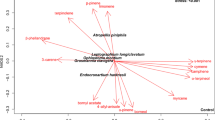Abstract
Correlation between the distributional frequency of undergrowth species of red pine forest and their germination and growth effected by pine extracts and leachates was found. It was made clear by germination and growth tests that pine toxic substances inhibit the germination and growth of low frequency species more than high frequency species in a red pine forest and that these substances are contained in descending concentration in fresh and fallen leaves, roots, pine forest soil, and pine rain. The concentration of pine toxic substances in extracts or leachates was affected by extracting or leaching within a given period of time, requiring a few hours for extracts or a few days for leachates. The amount of dry weight inhibition of the undergrowth treated by pine leachates was expressed as a growth inhibition index (GII) for the comparison of tolerance in various species. GII is a relative value (%) of the test groups against the control and it is an exponential function of the amount of pine toxic substances affecting the dry weight of the undergrowth. The substances were analyzed by paper and gas chromatography. Benzoic acid and 11 phenolic acids were identifed by gas chromatography. Benzoic acid was considered to be a key factor of allelopathy in the red pine forest.
Similar content being viewed by others
References
Abdul-Wahab, A.A., andRice, E.L. 1967. Plant inhibition by Johnson grass and its possible significance in old-field succession.Bull. Torrey Bot. Club 94:486–497.
Anderson, R.C., Katz, A. J., andAnderson, M.R. 1978. Allelopathy as a factor in the success ofHelianthus mallis L.J. Chem. Ecol. 4:9–16.
Ballester, A., Albo, J.M., andVieitez, E. 1977. The allelopathic potential ofErica scoparia L.Oecologia 30:55–61.
Bell, E.A. 1980. Non-protein amino acids in plants: Their chemistry and possible biological significance.Rev. Latinoam. Quim. 11:23–29.
Carballeira, A. 1980. Phenolic inhibitors inErica australis L.australis and in associated soil.J. Chem. Ecol. 6(3):593–596.
Chou, C.H., andYoung, C.C. 1974. Effects of osmotic concentration andpH on plant growth.Taiwania 19:157–165.
Corcoran M.R., Geissman, T.A., andPhinney, B.O. 1972. Tannins as gibberellin antagonists.Plant Physiol. 49:323–330.
De Bell, D.S. 1970. Phytotoxins: New problem in forestry?J. For. 68:335–337.
Dedonder, A., andVan Sumere, C.F. 1971. The effect of phenolics and related compounds on the growth and the respiration ofChlorella vulgaris.Z. Pflanzenphysiol. 65:70–80.
Glass, A.D.M. 1974. Influence of phenolic acids upon ion uptake. II. A structure-activity study of the inhibition of phosphate uptake by benzoic acid derivatives, pp. 159–164,in R.L. Bieleski, A.R. Ferguson, and M.M. Cresswell (eds.). Mechanisms of Regulation of Plant Growth. Bulletin 12. Royal Society of New Zealand, Wellington.
Gliessman, S.R., andMuller, C.H. 1978. The allelopathic mechanisms of dominance in bracken.J. Chem. Ecol. 4(3):337–362.
Halligan, J.P. 1976. Toxicity ofArtemisia californica to four associated herb species.Am. Midl. Nat. 95(2):406–421.
Hong, S.O. 1969. Endogenous growth substances affecting rooting of cutting of pines.Res. Rep. Inst. For. Genet. 7:1–33.
Horsley, S.B. 1977. Allelopathic interference among plants. II. Physiological modes of action, pp. 93–136,in H.E. Wilcox and A.F. Hamer (eds.). Proc. Fourth North Am. For. Biol. Workshop. College of Environmental Science and Forestry. Syracuse, New York.
Jackson, J.R., andWillemsen, R.W. 1976. Allelopathy in the first stages of secondary succession on the Piedmont of New Jersey. Am. J. Bot. 63:1015–1023.
Kil, B.S. 1981. Allelopathic effect ofPinus densiflora on the floristic composition of undergrowth in pine forests. PhD dissertation. The Chung-Ang University, Seoul, Korea.
Kobayashi, A., Shigeo, M., Shibata, Y., Yamashita, K., andNumata, M. 1980. C10-polyacetylenes as allelopathic substances in dominants in early stages of secondary succession.J. Chem. Ecol 6(1):119–132.
Kuwatsuka, S., andShindo, H. 1973. Behavior of phenolic substances in the decaying process of plants. I. Identification and quantitative determination of phenolic acids in rice straw and its decayed product by gas chromatography.Soil Sci. Plant Nutr. 19(3):219–227.
Lee, I.K., andMonsi, M. 1963. Ecological studies onPinus densiflora forest. I. Effects of plant substances on the floristic composition of the undergrowth.Bot. Mag (Tokyo) 76:400–413.
Li, C.Y. 1974. Phenolic compounds in understory of alder, coniferand mixed alder conifer stands of coastal Oregon.Lloydia 37:603–607.
Lodhi, M.A.K., andRice, E.L. 1971. Allelopathic effects ofCeltis leavigata.Bull. Torrey Bot. Club 98(2):83–89.
Lynch, J.M.,Gunn, K.B., andPanting, L. M. 1980. On the concentration of acetic acid in straw and soil.Plant Soil 93–98.
Molisch, H. 1937. Der Einfluss einer Pflanze auf die andere Allelopathie. Fischer, Jena, p. 20.
Mubarak, B., andHussain, F. 1978. Biochemical inhibition exhibited byDatura innoxia M. seeds.Pak. J. Bol. 10(2):149–156.
Muller, C.H. 1966. The role of chemical inhibition (allelopathy) in vegetational composition.Bull. Torrey Bot. Club 93:332–351.
Newman, E.I., andRovira, A.D. 1975. Allelopathy among some British grassland species.J. Ecol 63:727–737.
Numata, M. 1978. The role of allelopathy in early stages of secondary succession. Proc. VI. Asian-Pacific Weed Sci. Conf., pp. 80–86.
Putnam, A.R., andDuke, W.B. 1978. Allelopathy in agroecosystems.Annu. Rev. Phytopathol. 16:431–451.
Rice, E.L. 1974. Allelopathy. Academic Press, New York.
Rice, E.L. 1979. Allelopathy—an update.Bot. Rev. 45(1):15–109.
Stowe, G.L. 1979. Allelopathy and its influencing on the distribution of plants in an Illinois old field.J. Ecol. 67:1065–1085.
Toyohara, G. 1982. Red pine forest in South Korea (in Japanese). 29th Proceeding, The Ecological Society of Japan, Osaka, p. 68.
Ungar, I.A., andHorgan, W.C. 1970. Seed germination inIva annua.Ecology 51:150–154.
Yim, Y.J., andKira, T. 1975. Distribution of forest vegetation and climate in the Korean peninsula. I. Distribution of some indices of thermal climate.Jpn. J. Ecol. 25(2):77–88.
Author information
Authors and Affiliations
Rights and permissions
About this article
Cite this article
Kil, B.S., Yim, Y.J. Allelopathic effects ofPinus densiflora on undergrowth of red pine forest. J Chem Ecol 9, 1135–1151 (1983). https://doi.org/10.1007/BF00982217
Received:
Revised:
Issue Date:
DOI: https://doi.org/10.1007/BF00982217




